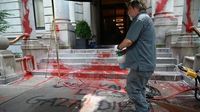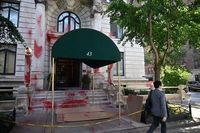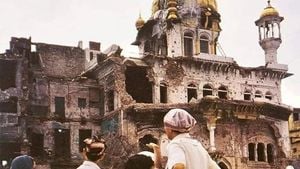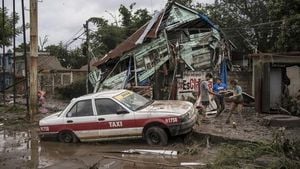Early Friday morning, the historic Greenwich Village apartment building where The New York Times executive editor Joseph Kahn resides was thrust into the spotlight—not for its storied past, but because it became the latest canvas for protest over the paper’s coverage of the Gaza war. Just before dawn on August 29, 2025, the New York Police Department responded to reports of vandalism at 43 Fifth Avenue, a building once home to celebrities like Marlon Brando and Julia Roberts. What officers found was hard to miss: red paint splattered across the steps, walls, sidewalk, and lamps, and a stark message in black marker on the pavement—"Joe Kahn Lies Gaza Dies."
The incident, confirmed by the NYPD and The New York Times, marks a new escalation in criticism directed at the paper and its leadership. Photos from the scene, widely circulated by outlets including NBC News and the New York Post, captured the vivid red paint streaks and the accusatory message, making clear that the protest was both personal and public.
According to police statements reported by NBC News, officers arrived at the scene in Greenwich Village at approximately 4:45 a.m. after receiving a call about graffiti. "Upon arrival, officers observed paint on the front steps and doors of the above location," the NYPD said. The investigation remains ongoing, and as of this writing, no arrests have been made.
Joseph Kahn, 61, has led the newsroom at The New York Times since 2022, steering the paper through some of the most contentious stories of recent years. The Times confirmed that Kahn was the intended target of the vandalism, underscoring the personal nature of the attack. Charlie Stadtlander, executive director for media relations and communications at the paper, condemned the act in a statement to The Hill: "People are free to disagree with The New York Times’s reporting but vandalism and targeting of individuals and their families crosses a line and we will work with authorities to address it."
This was not the first time the Times—or Kahn himself—was targeted in connection with its coverage of the ongoing war in Gaza. In late July, the Times’s headquarters in Times Square was similarly vandalized with red paint and the message "NYT lies Gaza dies" scrawled on its facade. That incident, too, remains under investigation, with police yet to identify suspects or make arrests. In March, pro-Hamas activists targeted the Times’ Queens printing facility, staging a protest with signs reading "Stop the presses. Free Palestine" and accusing the outlet of endorsing "genocide."
The recurring theme in these acts of protest is clear: a deep dissatisfaction among some activists and critics with the Times’s editorial stance on the Israel-Hamas conflict. A spokesperson for the paper, Danielle Rhoades Ha, contextualized this backlash, telling NBC News, "The war in Gaza is one of the most divisive global events in recent history." She added, "As an independent news organization, we receive criticism regularly from those representing entrenched perspectives, hoping to change our reporting. While we support the right of groups and individuals to express their point of view, we will not let advocacy groups sway us from covering the conflict fully and fairly."
The Gaza war, which erupted after Hamas’s October 7, 2023, attack that killed 1,219 civilians and resulted in the abduction of over 250 people, has polarized opinion worldwide. According to reporting by JFeed, the body of Ilan Weiss, one of those abducted, was recently recovered—an event that further inflamed passions on all sides. Critics of the protests argue that acts like the Greenwich Village vandalism reflect a surge in antisemitism, misdirecting blame toward Israel and its defenders while ignoring Hamas’s role in Gaza’s suffering. They point to the militant group’s use of civilian infrastructure and diversion of aid as exacerbating the humanitarian crisis, while activists often focus on Israel’s military actions.
Joseph Kahn’s own background has drawn attention in the aftermath of the vandalism. He comes from a Boston family with ties to Israel advocacy—his father, Leo Kahn, served as a board member of the Committee for Accuracy in Middle East Reporting in America (CAMERA). The building targeted on Friday is not only Kahn’s home but a historic Beaux Arts residence that has housed notable figures over the decades, adding a layer of symbolism to the attack.
For The New York Times, the latest incident is part of an ongoing struggle to balance the demands of objective reporting with the passions and pressures of a divided public. The newspaper has faced criticism from both sides of the Israel-Hamas conflict. Advocacy groups and activists have accused it of bias—some claiming the Times is too sympathetic to Israel, others charging it with being too critical. The July 30 vandalism at the Times’s headquarters came just a day after the paper issued a correction on an article about starvation in Gaza, highlighting how even editorial adjustments can become flashpoints in the broader debate.
Inside the newsroom, the attacks have prompted reflection but not retreat. "As an independent news organization, we receive criticism regularly from those representing entrenched perspectives, hoping to change our reporting," the Times reiterated in statements to multiple outlets. "While we support the right of groups and individuals to express their point of view, we will not let advocacy groups sway us from covering the conflict fully and fairly." Stadtlander’s message was equally resolute: "We will work with authorities to address it."
Yet, the personal targeting of Kahn and his family has struck a nerve. The Times’s leadership has drawn a clear line between robust debate and intimidation. "Vandalism and targeting of individuals and their families crosses a line," Stadtlander said, echoing a sentiment that resonates across the journalism community. The attacks have also reignited discussion about the safety and privacy of journalists, especially those in high-profile roles covering contentious issues.
Community reaction in Greenwich Village has been a mix of concern and defiance. Residents of the historic building—accustomed to the buzz of celebrity and the hum of city life—now find themselves at the intersection of global politics and local disruption. The sense of vulnerability is real, but so too is the determination to carry on. As one longtime neighbor put it, "We’re used to protests in the Village, but this feels different. It’s personal."
As of September 1, 2025, the NYPD’s investigation continues, with both the July and August incidents unresolved. The Times has pledged to cooperate fully with law enforcement and to support Kahn and his family. In the meantime, the red paint and graffiti have been cleaned, but the questions raised by the vandalism—about press freedom, protest, and the boundaries of dissent—linger on the city’s storied sidewalks.
For The New York Times and its executive editor, the message is clear: the stakes of reporting on the world’s most divisive conflicts are not confined to the printed page. They play out in real life, sometimes right at your doorstep.





